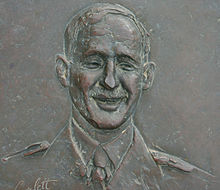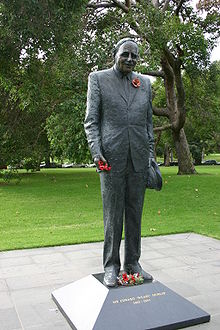Weary Dunlop

Lieutenant-Colonel Sir Ernest Edward "Weary" Dunlop, AC, CMG, OBE, KStJ (July 12, 1907 – July 2, 1993) was an Australian surgeon who was renowned for his leadership whilst being held prisoner by the Japanese during World War II. He was born in Wangaratta, Victoria, Australia.
Early life
After a childhood spent in Benalla in north-eastern Victoria, Dunlop graduated from the University of Melbourne in 1934 with first class honours in pharmacy and in medicine,[1] and excelled as a sportsman at Melbourne University and Ormond College, where he lived during his studies. Joining the Melbourne University Rugby Club progressing rapidly through the grades, representing Victoria, and then Australia in Rugby Union, being on the first Australian side to beat the mighty All Blacks. The surgeons leading qualification in London soon followed, and from there, when war broke out in 1939, he volunteered for the 2nd AIF.
War and imprisonment
During World War II, Dunlop was appointed to medical headquarters in the Middle East, where he developed the mobile surgical unit. In Greece he liaised with forward medical units and Allied headquarters, and at Tobruk he was a surgeon until the Australian Divisions were withdrawn for home defence. His troopship was diverted to Java in an ill-planned attempt to bolster the defences there. On 26 February, 1942, he was promoted to temporary lieutenant-colonel. Dunlop became a Japanese prisoner of war in 1942 when he was captured in Bandung, Java, together with the hospital he was commanding.
Because of his leadership skills, he was placed in charge of prisoner-of-war camps in Java, was later transferred briefly to Changi, and in January 1943 commanded the first Australians sent to work on the Thai segment of the Burma-Thailand railway.

After being held in a number of camps in Java, he was eventually moved to the Thai-Burma railway, where prisoners of the Japanese were being used as forced labourers to construct a strategically important supply route between Bangkok and Rangoon. Conditions in the railway camps were primitive and horrific — food was totally inadequate, beatings were frequent and severe, there were no medical supplies, tropical disease was rampant, and the Japanese required a level of productivity that would have been difficult for fully fit and properly equipped men to achieve.
Along with a number of other Commonwealth Medical Officers, Dunlop's dedication and heroism became a legend among prisoners.
A courageous leader and compassionate doctor, he restored morale in those terrible prison camps and jungle hospitals. Dunlop defied his captors, gave hope to the sick and eased the anguish of the dying. He became, in the words of one of his men, "a lighthouse of sanity in a universe of madness and suffering". His example was one of the reasons why Australian survival rates were the highest.
Post-war life
After 1945, with the darkness of the war years behind him, Dunlop forgave his captors and turned his energies to the task of healing and building. He was to state later that " in suffering we are all equal". He devoted himself to the health and welfare of former prisoners-of-war and their families, and worked to promote better relations between Australia and Asia.
He was active in many spheres of endeavour. In his own field of surgery, he pioneered new techniques against cancer. He became closely involved with a wide range of health and educational organisations, and his tireless community work had a profound influence on Australians and on the peoples of Asia. As well as numerous tributes and distinctions bestowed upon him in his own country, he received honours from Thailand, India, Sri Lanka, and the United Kingdom. It was ironic that a man of such enormous energy should be nicknamed "Weary" - a result of word association (Dunlop, tyre, tired, Weary) in his undergraduate days.
Honours and awards
'Weary' Dunlop received many honours and awards throughout his life, including; the Order of the British Empire (1947); Companion of the Order of Australia (1987), Knight Grand Cross of the Order of St John of Jerusalem (1992), Knight Grand Cross (1st Class) of the Most Noble Order of the Royal Crown of Thailand (1993); Honorary Fellow of the Imperial College London; Honorary Fellow of the Royal College of Surgeons of Edinburgh; Honorary Life Member of the Returned and Services League of Australia; and Life Governor of the Royal Women's Hospital and the Royal Victorian Eye and Ear Hospital. In 1976 he was named Australian of the Year and in 1988 he was named one of '200 Great Australians'. His image is on the 1995 issue Australian fifty cent piece with the words "They Served Their Country in World War II, 1939 - 1945". The fifty cent piece is part of a set including the one dollar coin and the twenty cent piece.
Notes
- ^ At that time, it was not uncommon for a student to first study pharmacy; because the gaining of a pharmacy diploma guaranteed advanced-level admission to a medical degree at Melbourne University.
External links
- Australian War Memorial Site
- Biography at Sir Edward "Weary" Dunlop Medical Research Foundation
- at Weary Dunlop Foundation
- Geddes, Margaret (1996). Remembering Weary. Ringwood, Vic: Viking. pp. 448p. ISBN 0670867055.
{{cite book}}: Cite has empty unknown parameter:|coauthors=(help)
- Australian military personnel of World War II
- 1907 births
- 1993 deaths
- Officers of the Order of the British Empire
- Australian surgeons
- Knights of the Order of St John
- Companions of the Order of St Michael and St George
- Companions of the Order of Australia
- People from Melbourne
- World War II prisoners of war
- Australian rugby union footballers
